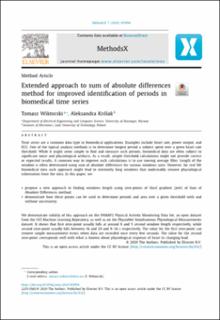| dc.contributor.author | Wiktorski, Tomasz | |
| dc.contributor.author | Krolak, Aleksandra | |
| dc.date.accessioned | 2021-01-29T14:29:17Z | |
| dc.date.available | 2021-01-29T14:29:17Z | |
| dc.date.created | 2021-01-27T10:36:54Z | |
| dc.date.issued | 2020-10 | |
| dc.identifier.citation | Krolak, A., Wiktorski, T. (2020) Extended approach to sum of absolute differences method for improved identification of periods in biomedical time series. MethodsX, 7, 101094. | en_US |
| dc.identifier.issn | 2215-0161 | |
| dc.identifier.uri | https://hdl.handle.net/11250/2725418 | |
| dc.description.abstract | Time series are a common data type in biomedical applications. Examples include heart rate, power output, and ECG. One of the typical analysis methods is to determine longest period a subject spent over a given heart rate threshold. While it might seem simple to find and measure such periods, biomedical data are often subject to significant noise and physiological artifacts. As a result, simple threshold calculations might not provide correct or expected results. A common way to improve such calculations is to use moving average filter. Length of the window is often determined using sum of absolute differences for various windows sizes. However, for real life biomedical data such approach might lead to extremely long windows that undesirably remove physiological information from the data. In this paper, we:
• propose a new approach to finding windows length using zero-points of third gradient (jerk) of Sum of Absolute Differences method;
• demonstrate how these points can be used to determine periods and area over a given threshold with and without uncertainty.
We demonstrate validity of this approach on the PAMAP2 Physical Activity Monitoring Data Set, an open dataset from the UCI Machine Learning Repository, as well as on the PhysioNet Simultaneous Physiological Measurements dataset. It shows that first zero-point usually falls at around 8 and 5 second window length respectively, while second zero-point usually falls between 16 and 24 and 8–16 s respectively. The value for the first zero-point can remove simple measurement errors when data are recorded once every few seconds. The value for the second zero-point corresponds well with what is known about physiological response of heart to changing load. | en_US |
| dc.language.iso | eng | en_US |
| dc.publisher | Elsevier Ltd. | en_US |
| dc.rights | Navngivelse 4.0 Internasjonal | * |
| dc.rights.uri | http://creativecommons.org/licenses/by/4.0/deed.no | * |
| dc.subject | biomedisin | en_US |
| dc.subject | tidsserier | en_US |
| dc.title | Extended approach to sum of absolute differences method for improved identification of periods in biomedical time series | en_US |
| dc.type | Peer reviewed | en_US |
| dc.type | Journal article | en_US |
| dc.description.version | publishedVersion | en_US |
| dc.rights.holder | © 2020 The Authors | en_US |
| dc.subject.nsi | VDP::Teknologi: 500::Medisinsk teknologi: 620 | en_US |
| dc.subject.nsi | VDP::Teknologi: 500::Informasjons- og kommunikasjonsteknologi: 550 | en_US |
| dc.source.volume | 7 | en_US |
| dc.source.journal | MethodsX | en_US |
| dc.identifier.doi | 10.1016/j.mex.2020.101094 | |
| dc.identifier.cristin | 1880168 | |
| dc.source.articlenumber | 101094 | en_US |
| cristin.ispublished | true | |
| cristin.fulltext | original | |
| cristin.qualitycode | 1 | |

